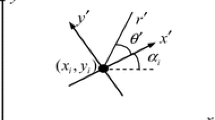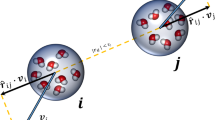Abstract
Dielectrophoresis (DEP) is an electrokinetics-based phenomenon that involves the motion of a particle due to the interaction between an applied nonuniform electric field and an induced dipole moment. This technique is very effective in particle manipulation and separation. Earlier studies on control-amenable models to describe the motion of a neutrally buoyant, neutrally charged particle in a chamber with a parallel electrode array have restricted the motion of the particle to one dimension. Here, incorporating the electro-thermal fluid motion as well, we present a 2D-planar DEP model and study the effect of electro-thermal fluid motion on particle trapping.












Similar content being viewed by others
References
Chang, D.E., Petit, N.: Toward controlling dielectrophoresis. Int. J. Robust Nonlinear Control 15(16), 769–784 (2005)
Chang, D.E., Loire, S., Mezic, I.: Closed-form solutions in the electrical field analysis for dielectrophoretic and travelling wave interdigitated electrode arrays. J. Phys. D, Appl. Phys. 36(23), 3073–3078 (2003)
Gielen, F., DeMello, A.J., Cass, T., Edel, J.B.: Increasing the trapping efficiency of particles in microfluidic planar platforms by means of negative dielectrophoresis. J. Phys. Chem. B 113(5), 1493–1500 (2009)
Green, N.G., Morgan, H.: Dielectrophoretic investigations of sub-micrometre latex spheres. J. Phys. D, Appl. Phys. 30(18), 2626–2633 (1997)
Green, N.G., Morgan, H.: Separation of submicrometre particles using a combination of dielectrophoretic and electrohydrodynamic forces. J. Phys. D, Appl. Phys. 31(7), L25–L30 (1998)
Green, N.G., Ramos, A., González, A., Castellanos, A., Morgan, H.: Electrothermally induced fluid flow on microelectrodes. J. Electrost. 53(2), 71–87 (2001)
Grom, F., Kentsch, J., Müller, T., Schnelle, T., Stelzle, M.: Accumulaion and trapping of hepatitis a virus particles by electrohydrodynamic flow and dielectrophoresis. Electrophoresis 27(7), 1386–1393 (2006)
Heida, T., Rutten, W.L.C., Marani, E.: Understanding dielectrophoretic trapping of neuronal cells: modelling electric field, electrode-liquid interface and fluid flow. J. Phys. D, Appl. Phys. 35(13), 1592–1602 (2002)
Hölzel, R., Calander, N., Chiragwandi, Z., Willander, M., Bier, F.F.: Trapping single molecules by dielectrophoresis. Phys. Rev. Lett. 95(12) (2005)
Huang, J., Wang, G., Tseng, K., Fang, S.: A chip for catching, separating, and transporting bio-particles with dielectrophoresis. J. Ind. Microbiol. Biotech. 35(11), 1551–1557 (2008)
Hughes, M.P.: Nanoelectromechanics in Engineering and Biology. CRC Press, Boca Raton (2002)
Hughes, M.P., Morgan, H.: Dielectrophoretic trapping of single sub-micrometre scale bioparticles. J. Phys. D, Appl. Phys. 31(17), 2205–2210 (1998)
Jones, T.B.: Electromechanics of Particles. Cambridge University Press, Cambridge (1995)
Jones, T.B., Bliss, G.W.: Bubble dielectrophoresis. J. Appl. Phys. 48(4), 1412–1417 (1977)
Jones, T.B., Kallio, G.A.: Dielectrophoretic levitation of spheres and shells. J. Electrost. 6(3), 207–224 (1979)
Jones, T.B., Kraybill, J.P.: Active feedback-controlled dielectrophoretic levitation. J. Appl. Phys. 60(4), 1247–1252 (1986)
Kaler, K.V.I.S., Jones, T.B.: Dielectrophoretic spectra of single cells determined by feedback-controlled levitation. Biophys. J. 57(2), 173–182 (1990)
Lapizco-Encinas, B.H., Rito-Palomares, M.: Dielectrophoresis for the manipulation of nanobioparticles. Electrophoresis 28(24), 4521–4538 (2007)
Morgan, H., Sun, T., Holmes, D., Gawad, S., Green, N.G.: Single cell dielectric spectroscopy. J. Phys. D, Appl. Phys. 40(1), 61–70 (2007)
Muller, T., Gerardino, A., Schnelle, T., Shirley, S.G., Bordoni, F., De Gasperis, G., Leoni, R., Fuhr, G.: Trapping of micrometre and sub-micrometre particles by high-frequency electric fields and hydrodynamic forces. J. Phys. D, Appl. Phys. 29(2), 340–349 (1996)
Pethig, R.: Dielectrophoresis: status of the theory, technology, and applications. Biomicrofluidics 4(2) (2010)
Pohl, H.A.: Dielectrophoresis. Cambridge University Press, Cambridge (1978)
Ramos, A., Morgan, H., Green, N.G., Castellanos, A.: Ac electrokinetics: a review of forces in microelectrode structures. J. Phys. D, Appl. Phys. 31, 3338–3353 (1998)
Thomas, R.S., Morgan, H., Green, N.G.: Negative dep traps for single cell immobilisation. Lab Chip 9(11), 1534–1540 (2009)
Tuval, I., Mezic, I., Bottausci, F., Zhang, Y.T., MacDonald, N.C., Piro, O.: Control of particles in microelectrode devices. Phys. Rev. Lett. 95, 236002 (2005)
Wood, J.A., Zhang, B., Tomkins, M.R., Docoslis, A.: Numerical investigation of ac electrokinetic virus trapping inside high ionic strength media. Microfluid. Nanofluid. 3(5), 547–560 (2007)
Zhang, C., Khoshmanesh, K., Mitchell, A., Kalantar-Zadeh, K.: Dielectrophoresis for manipulation of micro/nano particles in microfluidic systems. Anal. Bioanal. Chem. 396(1), 401–420 (2010)
Acknowledgements
The authors would like to thank professor D.E. Chang for introducing them to the field of modeling and control of a dielectrophoretic system. They would also like to thank the anonymous reviewers for their constructive comments, which greatly contributed to improving the quality of the paper.
Author information
Authors and Affiliations
Corresponding author
Additional information
Communicated by A. Szeri.
Appendix: Analysis of the Equilibrium Point/Points on \(\tilde {x}^{*}_{1}=\pm\frac{1}{2}\)
Appendix: Analysis of the Equilibrium Point/Points on \(\tilde {x}^{*}_{1}=\pm\frac{1}{2}\)
In this case, \(\dot{\tilde{x}}_{2}(\tilde{x}_{1} = \pm\frac{1}{2},\tilde {x}_{2})=0\) implies
Note that the existence and uniqueness of a solution for \(\tilde{x}_{2}\) in Eq. (31) depends on the signs of the terms \(\bar{v}_{\mathrm{dep}}\) and πβ−1. An equilibrium point exists on the \(\tilde{x}_{1} =\frac{1}{2}\) line only if \(\bar{v}_{\mathrm {dep}}<0\) and similarly on the \(\tilde{x}_{1} = -\frac{1}{2}\) line only if \(\bar{v}_{\mathrm{dep}}>0\). Assuming that this condition is satisfied, the existence and uniqueness (which depend on the sign of πβ−1) of the solution are studied next.
Case 1 \((\beta\geq\frac{1}{\pi} )\): The LHS of Eq. (31) is such that
Therefore \(\tilde{x}_{2}^{2} \mathrm{e}^{ (\frac{\pi \beta-1}{\beta} ) \tilde{x}_{2}}\) is a continuously increasing function of \(\tilde{x}_{2}\). Hence (31) has a unique solution. Further, since we have a condition on \(|\bar{v}_{\mathrm{dep}}|\) in (28), the unique solution for Eq. (31) is such that \(\tilde{x}^{*}_{2}(\bar{v}_{\mathrm{dep}}) < 2 \beta\).
Case 2 \(( \beta<\frac{1}{\pi} )\): In this case, we have a solution only if
Since \(\frac{\mathrm{e}^{-2}}{ (\pi \beta-1)^{2}} > \mathrm{e}^{2( \pi \beta-1) }\), from (28) and (32) we have
Therefore, the condition in (28) ensures that the condition in (32) is satisfied. Also, we have two solutions for the equation (31): one solution is such that \(\tilde {x}^{*}_{2}(\bar{v}_{\mathrm{dep}})< 2 \beta<\frac{2 \beta}{1-\pi \beta }\) and another is such that \(\tilde{x}^{*}_{2}(\bar{v}_{\mathrm{dep}})> \frac{2 \beta}{1-\pi \beta}> 2 \beta\).
The nature of these equilibrium points and their dependence on \(\bar {v}_{\mathrm{dep}}\) are studied next.
Nature of the equilibrium points: Let \(\tilde{x}^{*}_{2}\) be a solution (in case of \(\beta\geq\frac{1}{\pi}\)) or one of the solutions (in case of \(\beta< \frac{1}{\pi}\)) of Eq. (31). Then the Jacobian evaluated at the equilibrium point \((\tilde{x}^{*}_{1} = \pm\frac{1}{2}, \tilde{x}^{*}_{2})\) is given by
and the corresponding eigenvalues are
The signs of λ 1 and λ 2 in the different cases are summarized in Table 1. Note that in either case (\(\beta\geq\frac{1}{\pi} \) or \(\beta<\frac{1}{\pi} \)), we have λ 1 λ 2<0 and hence the equilibrium point/points on \(\tilde{x}^{*}_{1}=\pm\frac{1}{2}\) is/are always saddle points irrespective of the sign of the parameter \(\bar{v}_{\mathrm{dep}}\).
Rights and permissions
About this article
Cite this article
Simha, H., Banavar, R.N. A 2D-Planar Dielectrophoretic Model with Electro-Thermally Induced Fluid Motion and the Stability of Trapping Zones. J Nonlinear Sci 23, 1001–1021 (2013). https://doi.org/10.1007/s00332-013-9176-3
Received:
Accepted:
Published:
Issue Date:
DOI: https://doi.org/10.1007/s00332-013-9176-3




